I want to start off with a little story…
I had someone mention to me the other day, “Spring feels like it comes earlier, anymore. What do you think? Is there any weather information to back that up?”
They went on to mention that they used to wait until mid- to late-April to plant, but now they put plants in / seeds in the ground – depending on the year – around April 10th. At the moment, I didn’t have any research, that I knew of, to back that up. But I know that farmers tend to have a pretty good feel for things. One of my grandfathers was a farmer, and he was always pretty good at <em>feeling</em> what Mother Nature was telling him. I was intrigued, but put it in the back of my mind. I told myself, ‘I’ll look into that soon.’
Springing forwarder more quicklier
Then, this morning, I read a quick article from Climate Matters regarding Spring getting earlier each year during the last – roughly – 30 years.
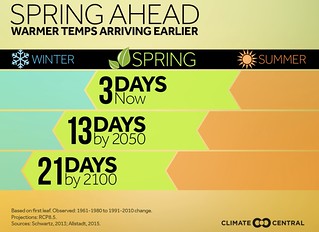
It defined Spring as the first budding plant. Climate Matters went on to show that because spring is earlier, the growing season is longer. And that brought me full circle back to the conversation that Spring is getting earlier.
It isn’t just that one man’s feeling. Research suggests it is – in fact – coming earlier every year. Recently, studies showed that it is coming about three days earlier.
And while that may not sound like a big deal, research may disagree. The graphic above, based on recent research, suggests that if the current trend continues, Spring may begin almost two weeks sooner than it used to by 2050.
I suppose the silver lining (for us southerners) is that the same research showed a disproportionate change between southern states and northern states. Things are changing more drastically in the north than in the south.
For example, here is the research showing the change in growing seasons – by year – for South Mississippi:
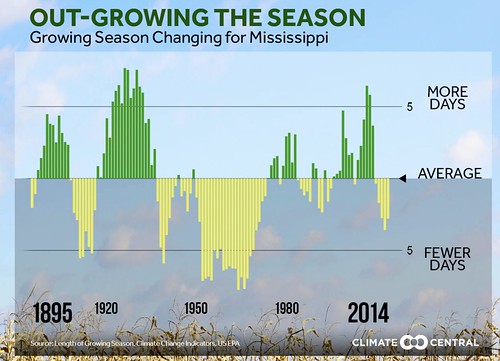
In Mississippi the swings have been – generally – within five days during the last 120 years. With a general trend that shows a few more growing days per year, but no big change.
But hey, even a day extra is a day extra!
Those extra days are nothing to sneeze at – or are they?
That longer growing season may be good news for farmers, but it is bad news for allergy sufferers.
That leads to people who suffer from allergies, to suffer longer.
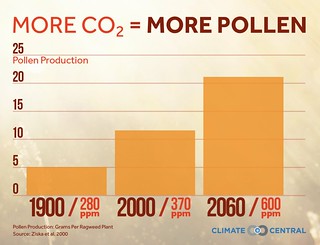
Then, there was also cited research suggesting that the pollen itself is becoming more numerous during the last 100 years.
As we continue to use coal, drive cars, and burn forests, it increases the atmospheric Carbon Dioxide. When there is more CO2, plants can use it as ‘food’ to make more pollen.
Take a look at these projections compared to 1900!
By 2060, some research suggests we may have about twice as much pollen in the air. People with stock in Flonase and Claritin might be feeling pretty good, right now.
Meanwhile, I bet that is a number that makes people who use those products want to stop driving a car all together! It makes me want to reconsider that summer campfire, too!
All right, jokes aside, that number is pretty amazing. Even if it is over-estimating, take a look at the pollen numbers in the graphic above comparing 1900 to 2000: A roughly 30-percent increase. That may explain while more and more people seem to be sneezing in the Spring then they used to – there is more pollen these days!
That more-pollen-causing-more-allergies thing is something that was discussed about two years ago by an Environmental Health Perspectives author, Charles Schmidt. Charles also suggested in that article that the increase in pollen and spores may also be contributing to more asthma cases, too.
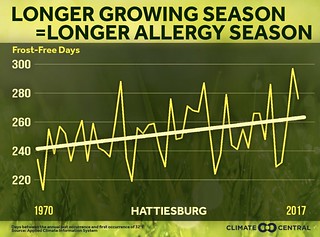
One of the very subtle changes with the extra greenhouse gases like CO2, methane, and water vapor, is the ability for the atmosphere to hold onto that little bit of extra heat overnight.
This happens because those gases like to trap longwave radiation trying to leave the atmosphere at night. It isn’t a lot of heat, but it is enough to change the temperature by half a degree here, a full degree there. Maybe even two degrees in some places.
A degree or two may not sound like a big deal in the grand scheme of things, but it can mean a lot to plants trying to sprout.
The warmer nights – by a degree here or there – can mean the difference between a frost and a freeze. Or a chilly night and a frosty night.
And that difference – over time – can determine whether a plant is going to sprout or not.
Plants are getting buff
Speaking of sprouting plants, here is one thing I didn’t know about until I started digging into the research… Plants can make more potent toxins with more CO2!
And while I hadn’t ever thought of it, it makes sense. Carbon Dioxide is food for plants. Of course when they get more of it, they can be stronger.
It isn’t any different for humans. The more food you eat, the stronger you can get (so long as you aren’t eating Cheetos on the couch).
Take a look at what has happened to Poison Ivy in the last few decades:
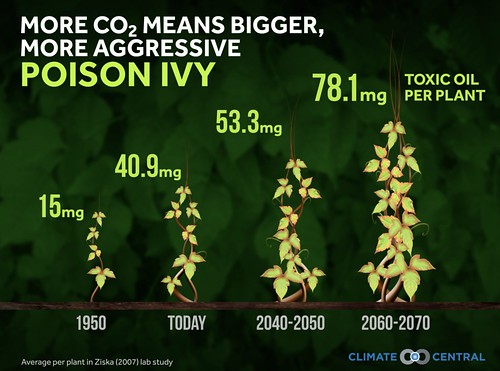
It is nearly three-times more potent than it was in 1950. Three times! That is almost unbelievable! Projections have it nearly five times more potent by the time kids born in 2000 retire.
It’s not all ‘doom and gloom’ about the blooms
I know this may seem like a Doomsday post, but I found it very interesting to see what affect our lives have on nature every day. It also makes me rethink just how much CO2 I’m putting into the air. Every little bit I can keep out of the air will help.
Because, man, no one likes Poison Ivy.

